Vol 2 No. 17 TROPIC LIGHTNING NEWS May 1, 1967
Index
 |
|
Operation 'Manhattan' Begins |
Cavalry Clears Highway
The 25th Inf. Div. Operation "Sabre Thrust" has cleared the main supply route
between Saigon and Tay Ninh City.
The 70 km stretch of strategically important road had previously been under
constant attack by enemy forces in their attempt to stop supply convoys.
The operation is being conducted by the 3rd Sqdn., 4th Cav. The key to their
success is mobility; armored personnel carriers, tanks and helicopter gunships.
The cavalry unit deploys its mechanized equipment over the route during the
day as hundreds of supply trucks in convoy make the long, hard, round trip.
Each night they take up positions along suspected enemy communication routes in
their 180 square mile area of responsibility.
The use of the M48 tank's Xenon searchlights, both white and infrared, have
made possible the successful interruption of enemy supply night operations
between the Cambodian border and such places as the Boi Loi and HoBo Woods. The
Xenon infrared light is capable of detecting the enemy in total darkness for
distances up to 1500 meters.
To date, Sabre Thrust has accounted for five VC killed by body count and
fourteen additional possible kills. Seventy-two Vietnamese who were without
proper identification have been detained. Several were found to be draft
dodgers while eight more were confirmed to be Viet Cong.
The cavalrymen have destroyed 21 fortified complexes consisting of hundreds
of bunkers, tunnels and punji pits. Several company and platoon size base camps
have been destroyed as well as more than 150 booby traps. Fifty pounds of
documents have been captured making possible the positive identification of at
least one enemy unit that has been active in the area.
U.S. casualties have been very light.
Slow, Detailed Search
A multi-division operation named "Manhattan" was kicked off April 23 as units
departed Cu Chi base camp for the Ho Bo and Boi Loi woods.
Three 25th Div. brigades are taking part in the pincer-type operation.
Joining the 25th is the 1st Inf. Div and 11th Armored Cavalry who will conduct
operations northeast of the Saigon River, while "Tropic Lightning" soldiers
cover the southwest side.
It's the first time a massive operation has been conducted in this area since
"Cedar Falls" early this year.
According to a division spokesman, the operation will be a slow and detailed
search of the woods. It's main purpose is to find and destroy VC base camps and
weapons caches, including any VC guerrilla units found in the area.
It is believed, the spokesman continued, that the Viet Cong's provincial
headquarters and a provincial regiment may be located in the woods. Although
found and destroyed during previous operations, military officials believe the
headquarters has been rebuilt.
Any sizeable force encountered will probably be an advance guard for the
provincial headquarters or regiment the spokesman emphasized.
River assault groups also were patrolling the river and engineers were
manning bulldozers and other heavy equipment to knock down the heavy foliage
that once provided the Viet Cong with a sanctuary.
In conjunction with Operation "Manhattan" but not an integral part of it, is
the 3rd Sqdrn., 4th Cav. operating in the Filhol Plantation area.
"It's all part of a campaign to keep unrelenting pressure on VC units in the
area and prevent their grouping," the spokesman concluded.
14th Inf. Finds Huge Weapons Cache
Enough weapons to arm two Viet Cong Infantry companies and one enemy heavy
weapons company was uncovered recently as the 25th Inf. Div.'s 2nd Bn., 14th
Inf. swept an area nine miles southwest of Saigon.
The battalion's Co. A, under command of Capt. John W. Byers of Elkton, Md.,
found the giant cache on two separate occasions as they swept through a
pineapple plantation in Long An Province.
The huge arms cache included: two 75mm recoilless rifles, two 57mm recoilless
rifles, one 81mm mortar, two 60mm mortars, five heavy machineguns, one 7.92mm
German Mauser rifle, one U.S. 30 caliber Enfield rifle, three Browning Automatic
Rifles, two 12 gauge shotguns, seven Soviet 7.62 carbines, four French 7.5
Mauser rifles, one CHICOM 7.62 sub-machinegun, 14 Thompson 45 caliber
sub-machineguns, seven 30 caliber carbines, 19 U.S. 45 caliber grease guns, four
30 caliber U.S. M-1 rifles, and 38 caliber Smith and Wesson revolvers.
In addition to the uncovered arms, more than 18,000 rounds of assorted small
arms ammunition were captured, and nearly 100 pounds of enemy documents, many
labeled top secret, were discovered, along with 20 ounces of opium.
Capt. Byers stated that the weapons were in perfect condition when found.
The enemy bunkers, now one of the main interests of the "Battle Dragons,"
were said to be exceptionally well constructed. With walls of 16-inch reinforced concrete
and roofs supported by steel beams, informed sources say the 30 by 20 foot
structures could possibly hold out against a direct hit by an eight inch
artillery round.
Intelligence officers from the 25th Inf. Div. have disclosed the enemy
documents captured give definite proof the area presently under search was a
main source for local VC weapons supply and repair. The documents indicate the
area was frequented by the 6th Bn. of the Military Regional VC Force, and by
such local companies as the 310th, 312th and the 313th.
| The following message from Lt. Gen. Bruce Palmer, commanding general, II
Field Force, has been received by the 25th Inf. Div. CG. "Upon the termination of Operation 'Junction City' and movement of your units to base camps for rest and refitting, I wish to express to you and your command my appreciation for an outstanding performance. "Junction City was a blow to the enemy. You can be proud of the contribution of your men to this victory. "I commend you and your command for another successful operation against the Viet Cong." |
Bobcats Return
The 1st Bn. (Mech) 5th Inf. "Bobcats" came back to Cu Chi last week for the
first time in more than 70 days.
The Bobcats have been attached alternately to the 196th Lt. Inf. Bde., the
2nd Bde., and the 3rd Bde., 4th Div. on a sustained operation northwest of Tay
Ninh near the Cambodian border.
Arty Strike Abruptly Ends VC Luncheon
A scheduled "Businessmen's Luncheon" recently received a rude jolt to its
program. As a Viet Cong platoon settled down to a routine lunch and perhaps
discussion period, 105mm howitzer rounds fired by Btry. A of the 1st Bn., 8th
Arty, upset their rice bowls and killed four of them. The artillery strike was
closely followed by a sweep through the area by Co. A of the 1st Bn., 27th Inf.
"Wolfhounds" who accounted for another enemy kill and the detention of 21 VC.
Co. A received automatic weapons and small arms fire as it approached the
enemy position but suffered no casualties. One Browning Automatic Rifle, one
M-1 rifle, one pistol and four hand grenades were captured as well as 25 pounds
of documents indicating that it was a command meeting that was broken up by the
artillery unit and the Wolfhounds. Accurate intelligence reports compiled by
the battalion made the successful operation possible.
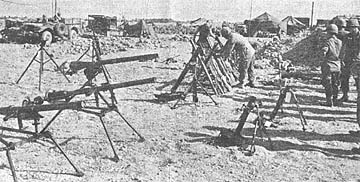 |
A portion of the huge weapons cache found by Co. A, 2nd Bn., 14th Inf., during a search and destroy operation nine miles southwest of Saigon. (See other photo on page 3.) The giant cache was surrounded by 32 booby traps. Weapons shown are (from left) 57mm recoilless rifles, 75mm recoilless rifles, 82mm mortars and 60mm mortars. In the rifle rack are French, German, Russian, CHICOM and American rifles. Documents found indicate the area was frequented by 6th Bn. of the Military Regional VC Force. (Photo by Sp4 Richard Calvo) |
Page 2 TROPIC LIGHTNING NEWS May 1, 1967
Decorated
| SILVER STAR | |
| SSgt. Russell V. Stith, Co. A, 2nd Bn., 1st Inf. |
Sp4 Carlton E. Frida, Co. A, 2nd Bn., 27th Inf. |
| SOLDIERS MEDAL |
|
| Capt. William I. Parks, Det. A, 323 A Comp., 5th Sp. Forces Gp. |
Sp4 Clifford K. Frye, Co. C, 2nd Bn., 12th Inf. |
| BRONZE STAR (VALOR) |
|
|
Lt. Col. William D. Brown, HHC, 25th Inf. Div. Capt. Geoffrey P. Ellerson, Co. C, 1st Bn., 27th Inf. Capt. Walter M. Smith, Co. B, 1st Bn., 27th Inf. 1st Lt. James D. Montavon, Co. A, 2nd Bn., 27th Inf. 2nd Lt. Richard M. Cummings, Co. B, 2nd Bn. (Mech), 22nd Inf. SSgt. John K. Davis, Co. B, 2nd Bn., 12th Inf. Sgt. David L. Stover, Co. A, 2nd Bn., 27th Inf. Sp5 Kim A. McCoy, HHC, 4th Bn., 9th Inf. |
Cpl. Matthew T. Orton, Co. A, 4th Bn., 9th Inf. |
| BRONZE STAR |
|
|
Lt. Col. William D. Brown, HHC, 25th Inf. Div. Lt. Col. Jose R. Salcedo, HHC, 25th Med. Bn. Maj. Glen W. Emery, HHB, 25th Inf. Div. Arty Capt. Frank J. Karoly, HHC, 4th Bn., 9th Inf. Capt. Phillip D. Mooney, 25th MI Det. Capt. John L. Overby, Btry B, 7th Bn., 11th Arty Capt. Richard R. Page, 25th Admin. Co. 1st Lt. Thomas J. Murphy, Co. B, 2nd Bn., 27th Inf. 1st Lt. Richard L. Nelson, HHC, 2nd Bn., 14th Inf. 1st Lt. Harry R. Stewart, Co. C, 2nd Bn., 27th Inf. WOl Earl R. Wills, HHC, 1st Bde. 1st Sgt. Dean L. Wilson, HHD, 25th Avn. Bn. SFC Edward P. Evanko, HHC, 1st Bde. PSgt. John A. Hamner, Co. A, 2nd Bn., 27th Inf. |
SFC Donald E. Rogers, HHC, 4th Bn., 9th Inf. |
| ARMY COMMENDATION MEDAL (VALOR) |
|
|
Capt. Joseph S. Gleason, HHB, 25th Inf. Div. Arty Capt. Lawrence H. Prather, HHC, 2nd Bn., 34th Armor Capt. Jackson K. Schultz, Co. A, 25th Avn. Bn. 1st Lt. John W. Leek, Co. A, 1st Bn. (Mech), 5th Inf. 1st Lt. James P. McKnight Jr., Co. A, 4th Bn. (Mech), 23rd Inf. |
2nd Lt. Thomas F. Tonkin, Btry A, 11th Bn., 23rd Arty |
| AIR MEDAL |
|
|
Capt. Stuart J. Crow, HHC, 65th Engr. Bn. Capt. William R. Dean Jr., Co. A, 25th Avn. Bn. 1st Lt. Jesse P. Forester Jr., Co. A, 25th Avn. Bn. 1st Lt. Lawrence F. Sack, Co. C, 4th Bin. (Mech), 23rd Inf. 2nd Lt. Rodger A. Renzulli, HHC, 65th Engr. Bn. 1st Sgt. James B. McCrory, Co. E, 725th Maint. Bn. |
Sp5 Ronald D. Holmes, Co. A, 25th Avn. Bn. |
| ARMY COMMENDATION MEDAL |
|
|
Capt. Emmett H. Helms, HHC, 25th S&T Bn. Capt. David K. Towers, HHC, 25th S&T Bn. 1st Lt. Robert M. Bales, HHC, 2nd Bn., 12th Inf. CW2 Boyce W. Allen Jr., Co. E, 725th Maint. Bn. MSgt. Leslie R. Draper, HHC, S&T Bn. |
MSgt. William J. Lane, HHC, 25th Inf. Div. |
Red Cross 24 Hr. Job
No matter what time of day or night, the American Red Cross at Cu Chi has its
doors open and is ready to serve the soldiers of the 25th Inf. Div.
A Red Cross staff member is on hand at all times in case of emergency and, by
the number of messages transmitted, it looks like that man is busy all the
time. An average of 700 electrical communications are handled each month by the
office. Most are dealing with emergency leaves, birth announcements or reports
of illness of a soldier's relatives.
Approximately 480 letters are mailed each month between the Cu Chi Red Cross
office and other field offices or chapters in the United States. The letters
are not of an emergency nature but concern important personal or family
problems.
The office is open with a full staff during normal duty hours seven days a
week. At least one worker is available in the office following normal working
hours. At least one worker is available in the office following normal working
hours. An appointment is not necessary.
The office is located in the division headquarters area directly west of the
headquarters flag poles. Unit commanders and senior NCOs are encouraged to
acquaint themselves with the office personnel and the services available to them
and their men. The phone numbers are Cu Chi 152 and 272.
Editorial
Today Is Law Day USA
By Capt. Arch T. Allen, Staff Judge Advocate's Office
Law Day USA will be observed on May 1, 1967. President Johnson, in
proclaiming the date, requested the people of our country to give recognition
and support to its observance. The Secretary of the Army has urged the Army to
participate fully in its observance.
Although the men of the 25th Inf. Div. are far from their homeland, Maj. Gen.
John C.F. Tillson III, Division commanding general, has urged the members of his
command to participate in the observance of Law Day USA by reflecting upon its
purpose and meaning.
The purpose of this day is to call special attention to the American Rule of
Law; its meaning is the pride we Americans take in being governed by law, not
men.
We Americans should be proud of the Rule of Law. That we are here in Vietnam
should increase our pride, for, as stated by Gen. Tillson, "Our Rule of Law is
here with us, as we fight to protect it. That our Constitutional Rule of Law
follows our flag is a sound reason for us to observe Law Day USA."
From Gen. Tillson's statements it may be seen that the men of the Tropic
Lightning Division have a special interest in our Rule of Law. For, not only do
they live under it, they fight for it as well. They may ask themselves,
however, "What is this Rule of Law?"
Before answering that question, it should be made clear that all laws do not
necessarily comply with the Rule of Law. History teaches us that many laws have
been tools of oppression enacted by tyrants to control people rather than
protect them.
Tyranny can come from many sources, either international or domestic,
governmental or private. Therefore, the Rule of Law has many aspects.
For instance, international law is one aspect, and it is emerging with the
hope that nations can learn to live peacefully with one another. When the hope
for peace collapses and one nation must fight to protect itself from
international tyranny and conquest, international law provides guiding rules for
conducting war and treating prisoners.
Another aspect of the Rule of Law is the criminal law system, which is
designed to protect the people in their persons and properties from murderers,
robbers and other such criminals. Obviously, a person of his family may be
tyrannized by an armed burglar as easily as by an armed agent of a dictator or a
foreign soldier.
The different aspects of the Rule of Law result from the complexity of its
purpose which, as we have seen, is to protect the people from tyranny from any
source. Thus, we must have armed forces to protect us from domestic crime. Our
Constitution provides for our defense by authorizing armed forces; it provides
for our protection by authorizing police.
But history reveals that many tyrants have had armies and police. The
distinction between their armies and police and our armies and police lies in
another aspect of our Rule of Law, for our armies and police are subject to our
Rule of Law just as our entire government is subject to it. This distinction
determines whether a legal system complies with the Rule of Law. To exist, the
governed people must be protected from possible tyranny at the hands of their
government. This protection is the keystone of the American Rule of Law.
Our Constitution not only established our government and authorized our
armies and police, it also limits the power they may exercise. It limits the
power our government exercises over us in two ways. First, the government has
no power not granted to it by the Constitution. Second, the government is
prohibited from exercising certain powers. Simply stated, our government
derives the government is prohibited from exercising certain powers. Simply stated,
our government derives its power from and is subject to the Constitution.
Our Constitution is the basis of our Rule of Law. Under it, we are not at the
mercy of our rulers; they are at the mercy of the ballots cast on election day.
They may not compel us to think as they do, for the Constitution guarantees our
freedoms of speech, press and assembly. The Constitution protects us from
unreasonable arrests and our homes and persons from unreasonable searches. It
guarantees those accused of committing crimes a fair and speedy trial, where
they must be represented by an attorney and judged by their fellow citizens if
they so desire.
These are but a few of our Constitutional guarantees. There are others, such
as the guarantee that all citizens be afforded equal protection of the law.
This Constitutional provision is emphasized by this year's Law Day USA theme,
"No man is above the law, and no man is below it."
There is much more to be said about the Rule of Law. These few words are
offered only as a brief explanation of it. It is hoped, however, that as the
men of the Tropic Lightning Division fight for our country, they may have
learned more of the importance to them of defending the Rule of Law; they defeat
tyranny.
25th Breaks Old Re-up Record
A new 25th Inf. Div. reenlistment record was set during the month of March.
The record 89 reenlistments was the highest single month total since the
division's arrival in Vietnam.
The previous one month high was 78, set in November of last year.
Colonel Francis Conaty's 1st Bde., with SFC Kenneth Binder as career
counselor, topped brigade sized units with 21 reenlistments. Four of these were
US personnel and nine were RA's with less than 48 months duty.
SFC Bill Hummer reenlisted 19 men from units within his area of
responsibility. These units are not under a brigade size command.
Support Command also made a good showing with 10 re-ups, two of which were
young RA's with less than four years service.
Battalion size units were led by the 2nd Bn., 14th Inf., with seven
reenlistments, followed by the 2nd Bn., 27th Inf., with four.
Top reenlistment bonus of the month went to Sgt. Francis Akina, HHC, 1st
Bde., who received $7,407, entirely tax free, for his six-year re-up.
The TROPIC LIGHTNING NEWS is an authorized publication of the 25th Infantry Division. It is published weekly for all division units in the Republic of Vietnam by the Information Office, 25th Infantry Division, APO San Francisco 96225. Army News Features, Army Photo Features, Armed Forces Press Service and Armed Forces News Bureau material are used. Views and opinions expressed are not necessarily those of the Department of the Army. Printed in Tokyo, Japan, by Pacific Stars and Stripes.
Maj.Gen. John C. F. Tillson III . . . . Commanding General
Maj. Bernard S. Rhees . . . . . . . . . . . Information Officer
Capt. John P. Fortner . . . . . . . . . . . . Officer-in-Charge
SSgt. David G. Wilkinson . . . . . . . . Editor
Sp4 Terry S. Richard . . . . . . . . . . . . Editorial Assistant
Sp4 John R. Dittmann. . . . . . . . . . . . Editorial Assistant
Page 3 TROPIC LIGHTNING NEWS May 1, 1967
'Old Guards' at War With Ivy Div. 3rd Bde.
About four weeks ago a number of Ivymen from the 3rd Bde., 4th Inf. Div. were
standing guard over President Kennedy's grave, others were riding coal black
horses in solemn military funerals. Some stood at the site of the Unknown
Soldier in the serenity of the Arlington National Cemetery nestled on the ground
of Robert E. Lee's mansion in Virginia. These men were assigned to the 1st Bn.,
3rd Inf.: the "Old Guards."
Called the "Buff Sticks" because of their flawless spit and polish
appearance, the Old Guard accompanied President Johnson to his private airplane
when he departed for his recent trip to South East Asia. The men are all hand
picked and must be over 5 feet, 10 inches tall, but not more than 6 feet, 3
inches in height. Each "Buff Stick" must not weigh more than 200 pounds, be a
high school graduate, have obtained a general aptitude test score of 110 or
better. Each man must be mature, mentally alert and spotless in his appearance.
PFC Larry D. Daley, of Memphis, Tenn. was an Old Guard, and now he's an
infantryman with the 2nd Bn. (Mech), 22nd Inf.
PFC Gary M. Brixen, of Ossee, Wis. was also an Old Guard and is now with Co.
A, 3rd Bn., 22nd Inf., the unit which took the blunt of a recent human wave
attack by the rugged 272nd Main Force Viet Cong Regiment.
PFC William D. Walker, of Grosse Point Farms, Mich. was once a "Buff Stick"
and is now a clerk in the brigade's civic action section.
"The 1st Bn., 3rd Inf. is the oldest infantry unit in the United States,"
Walker said. "It has 39 battle streamers just from the Indian War to World War
I."
Working mostly in the Washington, D.C. area the Old Guards is the only unit
authorized horses. They supply caissons with animals for all dignitaries
arriving at the Nation's capitol. "The size of the parade was determined by the
importance of the visitor." Walker said.
The unit is also a combat ready battalion - a full company was levied by the
Department of the Army and now the men are scattered throughout Vietnam.
Other Old Guards now with the 3rd Bde., 4th Inf. Div. are: PFC Russell J.
Enlow, of Oak Lawn, Ill.; Sp4 George Owens, of Neb.; PFC Morgan Dudley, Jr., of
Kansas City, Mo.; PFC Edward Ford, of Washington, D.C.; PFC Robert E. Tyler, of
Alexandria, Va.; and PFC Alvin D. Fisch, of Wayne, N.J.
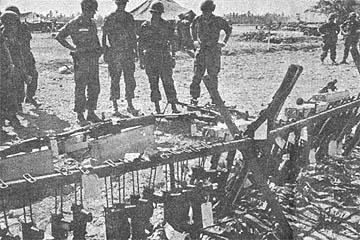 |
Maj. Gen. John C. F. Tillson III (2nd from rt.), 25th Inf. Div. commander, inspects weapons found cached by VC in an area nine miles southwest of Saigon. The weapons were discovered by the 2nd Bn., 14th Inf. (Photo by Sp4 Richard Calvo) |
'Makalapa' Uncovers VC Bunkers Hidden Beneath Pineapple Field
Pineapples, pineapples everywhere. As far as you can see the golden fruit
fills the tropical fields. Sound like Hawaii? The area is actually a
battlefield in the Vietnamese War, southwest of Cu Chi. The "Pineapple Field"
has long been considered a Viet Cong stronghold, with repeated operations making
contact with enemy forces in the area.
The "Wolfhounds" of the 1st and 2nd Bn's., 27th Inf. are discovering just how
strong the area is during their part in Operation "Makalapa."
Along the edges of the fields filled with the tropical fruit they have
uncovered and destroyed hundreds of solid Viet Cong bunkers. More than 600 enemy bunkers, 100 of
which were constructed of concrete, have been destroyed by the 2nd Bde. forces
working with the 34th ARVN Ranger Bn.
The brigade force has found natural vegetation, including pineapple plants,
transplanted into the mud surrounding VC bunkers to hide them from the American
soldiers. Many of the bunkers have been boobytrapped, but casualties in the
operation have remained extremely light.
Hundreds of pounds of extra explosive were airlifted into the area to
complete demolition of the fortified positions. Brigade intelligence officers have estimated that
many of the bunkers could have taken a direct hit by artillery without being
destroyed.
One large field hospital and a sizable weapons cache have been uncovered by
the 34th ARVN Rangers working with the Wolfhounds.
| Men of the 1st Bn, 27th Inf. search an area in the "Pineapple Patch" south of Duc Hoa on Operation "Makalapa II." The chimneys in the background are part of oven systems found on the huge pineapple plantation. (Photo By 1st Lt. Al Karel) |
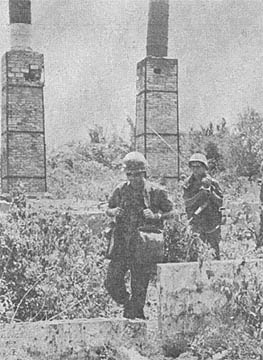 |
Captain Tells Of VC Attack
"I was in my jeep out by the airstrip when I saw the first rounds fall to the
southeast of the camp. At first I thought they were our own defensive
concentrations which we were firing, but when they started to move toward the
camp, I told my driver to get moving."
This was how Capt. Jerry R. Jeffrey of Charleston, W. Va. Btry C, 2nd Bn.,
77th Arty., commander related the story of his actions during a mortar attack on
the Prek Klok CIDG camp while his battery was there providing artillery support
for the 3rd Bde., 4th Div. on Operation "Junction City."
"My driver took that jeep down the road leading into the camp at about 50
miles an hour. As we reached the outer wire two rounds exploded on both sides
of the jeep about 20 meters away," he continued.
"Inside the camp I headed for the Special Forces command post which is within
the second perimeter. Just as I got into the bunker, the ammo dump was hit and
the blast just about policed me up.
"The ammo explosion knocked out all the communications in the camp so I
picked up a PRC-25 radio and went out to the outer embankment and adjusted the
defensive concentrations in the woodline to the east. All I could think was
that "Charlie" was going to hit us the same way he did at Soui Tre."
On March 21, Captain Jeffrey's battery was with the artillery battalion which
was attacked with mortars and 2500 Viet Cong in human wave assaults.
"The attack lasted about 30 minutes but it seemed like four hours. When that
first airstrike came in, it was the prettiest thing I saw all night," he
concluded.
Viet Medals Awarded to 3
Three 25th Inf. Div. soldiers were presented Vietnamese Crosses of gallantry
during a recent Army of the Republic of Vietnam ceremony held at Hau Nghia
Province's capital city of Bau Trai.
Receiving the awards were: 1st Lt. Ronald B. Benton of Guthrie, Okla., aide
to the assistant 25th Div. commander; 2nd Lt. Edwin B. Cravey of Houston, Tex.,
a platoon leader with Co. B, 1st Bn., 27th Inf.; and PFC Willie G. Richardson of
Trenton, N.J., a machine gunner with Co. A, 1st Bn., 27th Inf.
The medals, awarded for exceptional gallantry against a hostile force in the
Republic of Vietnam, were an expression of the grateful people to their American
allies.
Tiger Tales . . .
A tiger almost had a platoon by the tail near the 1st Bn., 27th Inf.,
temporary base camp during Operation "Malakapa II."
An element of Co. C on perimeter guard at night sighted a tiger. The tiger
was guarding his own perimeter and it appeared to be a standoff. The guard
element called back to the company control point asking permission to fire.
Permission to fire was refused.
Capt. Jerry 0. Parrish, of Lincoln, Ala., commanding officer of Co. C, said,
"I didn't let them shoot, because I thought they might be having nightmares."
'Alamo' Is Torn Down
The 2nd Bde.'s own "Alamo" is heading for its end. Progress and a new metal
quonset hut will replace the old structure that has stood since the Brigade
first occupied Cu Chi.
The Alamo is the huge sandbag bunker located at the corner of the
headquarters area. It has served as the communications center for the unit
since early in 1966 when the 2nd Brigade Task Force first fought its way into
the Cu Chi base area.
The mammoth bunker was the first permanent fortified position in the base
camp, and stood up under the nightly mortar attacks that the Viet Cong threw at
Cu Chi for those first months.
There are 30,000 sandbags in the walls of the Alamo, said wire foreman SSgt.
James Ellard of Bessemer, Ala. "They were all filled by members of the commo
platoon when security in the base camp meant sleeping next to your rifle."
Uprights inside the bunker are solid beams, eight inches square. "Only the
most solid timber was used to build it," said Ellard. But a year in the heat
and rain of Vietnam can do a lot to any building, and the Alamo has been getting
weaker.
"During the last mortar attack, a close hit brought a shower of dust and dirt
down inside one of the rooms," said Maj. Robert Duncan, brigade communications
officer. "The new building will offer us more room in a more comfortable
layout," he explained.
"The men in the commo platoon see the advantages of the new commo center,"
said commo platoon leader 1st Lt. Peter McGuire, "but they're sure going to hate
to leave the old Alamo."
Aviation Bn. Command Change
Maj. Gen. John C.F. Tillson III, commanding general of the 25th Inf. Div.,
presented the colors of the 25th Avn. Bn. to it's new commander, Lt. Col.
William A. Bearden, at ceremonies here April 10.
Col. Bearden succeeds Lt. Col. Edward P. Davis. He came to the 25th from Fort
Wolters, Tex., where he served as director of the Flight Division of the U.S.
Army Primary Helicopter School. He recently received his Master Aviator rating,
after 15 years as an Army aviatior.
Col. Bearden's wife and three children reside in Mineral Wells, Tex.
Page 4-5 TROPIC LIGHTNING NEWS May 1, 1967
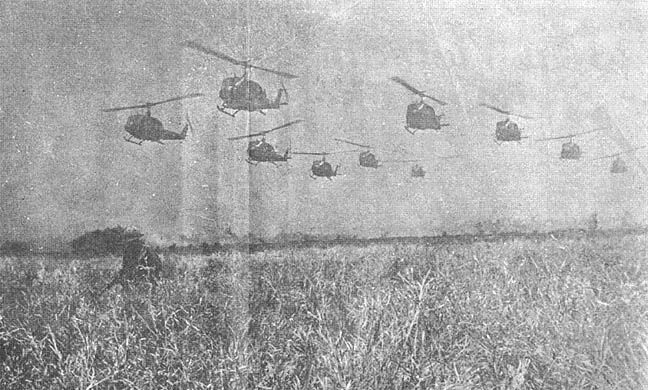 |
| HELILIFT - "Hornets" of the 116th Avn. Co. prepare to touch down in the pineapple patch long enough to unload their precious cargo. Minutes earlier the "Wolfhounds" had boarded the choppers to be transported to the new battle area for Operation "Makalapa." |
Search And Destroy And Relax In A Pineapple Plantation
Story and Photos
by 1st Lt. Doug Hudson
On Operation "Makalapa," the 1st Bn., 27th Inf. "Wolfhounds" are definitely
keeping Charlie on his toes. The rugged, abandoned pineapple fields near the
Oriental River south of Cu Chi certainly hold no resemblance to an R&R spot, but
appear more like a large "soil bank" project, where the land hasn't been
cultivated for a long time.
The men of the 25th Inf. Div. are finding that the fields are heavily
infested with VC fortifications. Most of the berms around these pineapple
patches are full of bunkers, spider holes and other fortifications that are
replete with booby traps.
The search and destroy missions being conducted are slow and tedious.
However, an amazing number of VC bunkers and structures have been destroyed.
Charlie knows that the Wolfhounds are on his trail, and they aren't giving
him a chance to holler "Wolf."
When asked why he needed all of the grenades he was carrying, one soldier
replied, "We haven't got the proper ingredients to serve Charlie a real Mai Tai
so we have to serve him these small refreshments instead." Another trooper
stated he had occasion to serve a hot M-60 stew to Charles the other day.
Certainly the fact that the 116th Avn. Co., "Hornets", keep bringing in more
Wolfhounds must be giving Charlie a terribly upset stomach.
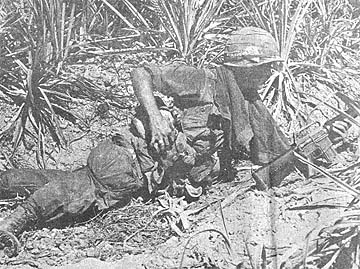 |
ANTICIPATION - A "Wolfhound" reaches for a grenade while lying between the berms in a pineapple patch during Operation "Makalapa II" near the Oriental River. |
| REFRESHING - The juice of a fresh, although not always sweet, pineapple can be mighty good on a hot day. A "Wolfhound" takes advantage of "Charlie's" crop. |
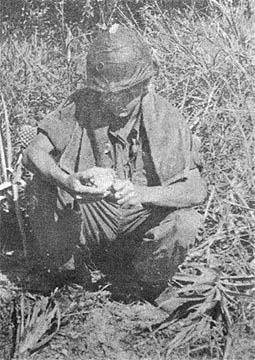 |
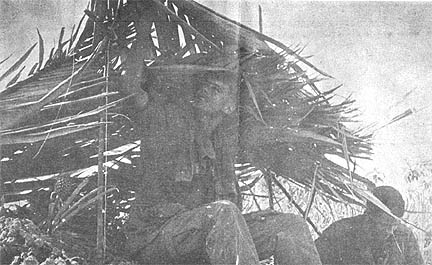 |
LITTLE GRASS SHACK - Two "Wolfhounds" of 1st Bn., 27th Inf. erect a temporary shelter from nearby palm groves. One checks out the overhead support of the 'hut' while the other cleans his weapon in preparation for an eagle flight. The men had been moving in the hot sun for several hours. When chow time came around the men wasted no time in obtaining shade. |
| THAT'S AFFIRMATIVE - A radio transmitter operator catches a few minutes of shaded rest during Operation "Makalapa." His equipment at his side, this "Wolfhound" is ready to relay information when the need arises. Having read the paper, it is further utilized for shade in the heat in the open pineapple patch. |
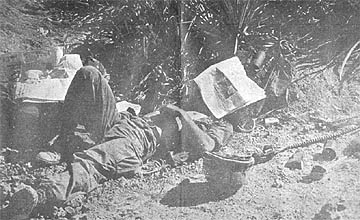 |
Page 6 TROPIC LIGHTNING NEWS May 1, 1967
All French Bn.
4/23 In Vietnam For Second Time
The history books are filled with feats of heroism and the tenacious fighting
ability of the men of the 4th Bn., 23rd Inf. from the battlefields of Korea and
Indochina to the present conflict in Vietnam.
At one time in its history, the battalion's ranks were filled with French
Volunteers who fought in Korea and later against the Viet Minh.
The relatively young battalion was born of the Korean Conflict, when the
United States' 23rd Inf. Regt. battled the frenzied Chinese Communists along
Korea's Naktong River.
In the early stages of the Korean Conflict, a vote of the UN Security Council
elected to send an international U.N. force to aid the already present allied
forces in the Korean Republic. The Fourth Republic of France, as many other
governments, immediately asked for U.N. volunteers from their military ranks.
When the United Nations forces finally reached the battle field in 1950, the
unit of French volunteers was attached to the American 23rd Inf. Regt. and
became the 4th Bn. of the 23rd Inf.
The 4th Bn. proved their value in the days to come by repelling concentrated
attacks on the critically important "Arrow Head Ridge."
They had always held their ground with such determination that, at the end of
the war, the unit was awarded the Korean Presidential Unit Citation
With the end of the Korean Conflict, the 4th Bn. was ordered by France to
Into-China, where Viet Minh rebels were trying to overthrow the government in
Vietnam.
Still wearing American patches on their shoulders, the "Battalion de Coree",
as they were called by their fellow countrymen, pushed their way through the
rebellious jungles in Vietnam. Many battles with the Viet Minh followed, and
with every battle, the fame of the battalion grew.
Seven months later, in the early part of July 1954, talks were begun for a
permanent Viet cease fire. In Geneva, French statesmen were working out
suitable conditions for peace; and in France, the Premier had promised a cease
fire by late July.
It seemed almost certain now that the courageous French battalion would
return gloriously to its mother country. But no - French Zone Headquarters had
planned one last operation.
Named "Forget-Me-Not," the operation was intended to clear a mass of Viet
Minh regulars which had infiltrated into an area between the cities of Pleiku
and Ban Me Thuot and now were interdicting supply and communications between the
two cities. It would be a murderous operation for the already weary,
understrength battalion.
On July 17, 1954, while escorting a convoy just south of Pleiku, the French
battalion was ambushed by an estimated brigade-size Viet Minh force. The battle
raged for several hours with the French repelling the enemy again with hand to
hand combat.
When it was over, the outnumbered French battalion was no more. All the
brave men who had once composed the 4th Bn. of the American 23rd Inf. Regt. were
dead. They fought to the last man never giving an inch.
Four months later, the rest of the American regiment returned to the United
States from Korea. At Fort Richardson, Alaska, in 1963, nine years after the
bloody ambush, a new 4th Bn., 23rd Inf. was organized.
Since then, the battalion has again returned to Vietnam and U.S. 25th Inf.
Div. at Cu Chi.
2nd Bde. Soldier Wins SS, BSM
The nation's third and fourth highest awards for gallantry were presented to
Sp4 Riley Brassfield by Maj. Gen. John C. F. Tillson III at ceremonies held
recently at 2nd Bde. Hq.
Both medals were earned by Brassfield when he was a member of Co C, 1st Bn.
(Mech), 5th Inf.
The Silver Star was awarded for his actions during Operation "Sunset Beach"
in September of 1966. Brassfield, in charge of a listening post, had just given
a situation report when a Chinese hand grenade was hurled into the position.
Brassfield instantly threw himself over an exposed comrade. He sustained
extremely painful wounds while saving the other man's life.
Hearing sounds to his front, he made another report and ordered grenades to
be thrown toward the noises. Not knowing the size of the force he faced,
Brassfield grasped a machinegun, and painfully standing, began to fire toward
the enemy.
Inspired by his example, the other men began firing while the three walked
backward into the battalion perimeter, firing all the way.
Brassfield received the Bronze Star with "V" Device for his actions during
Operation "Coco Palms" in June of 1966. His fire team had been taken under
extremely heavy automatic weapons fire from a fortified VC bunker. Exposing
himself to the intense fire, Brassfield maneuvered to within hand grenade range,
and threw two grenades into the front firing port. The bunker was completely
destroyed.
Brassfield, of Pueblo, Colo. is now a member of the 2nd Bde. personnel
section.
3rd Bn., 82nd Arty Fight And Assist
Using one hand to fight the Viet Cong and the other to assist the people of
South Vietnam, the 196th Lt. Inf. Bde. 3rd Bn., 82nd Arty., has made its
presence felt in a two-front war.
Commanded by Lt. Col. Warren L. Clark, Fayetteville, N.C., the "Flying Red
Horsemen" of the artillery battalion have accomplished much since arriving in
Vietnam in August 1966.
The battalion has succeeded in balancing its activities between fire missions
on the VC and civic action projects for the people of Tay Ninh Province, where
the brigade was based.
In the three largest ground operations of the war, "Attleboro," "Cedar
Falls," and "Junction City," the battalion's 105mm howitzers have played a major
role in the fight to deny the VC the use of War Zone "C".
Pouring thousands of rounds of high explosives onto the enemy locations, they
have enabled infantrymen from the brigade and other allied forces to penetrate
jungles held by the Viet Cong with the fewest possible friendly casualties.
On a typical 82nd Arty MEDCAP (Medical Civic Action Program), approximately
150 Vietnamese attend to be treated for diseases ranging from pneumonia to
smallpox. The children anxiously await the candy, soap, clothing, toothbrushes,
toothpaste, and other hygienic aids that are always passed out.
VC Tax Lost
The "Wolfhounds" do not sympathize with tax collectors; they shoot them.
On a recent eagle flight during the 25th Inf. Div.'s Operation "Makalapa" the
1st Bn., 27th Inf. made contact with a small Viet Cong element. When the smoke
cleared and the body count was complete, the Wolfhounds discovered they had hit
a Viet Cong tax collector. The tax collector was carrying a bag of Piasters
which was turned over to Lt. Col. H. H. Perritt, the battalion commander, for
further disposition.
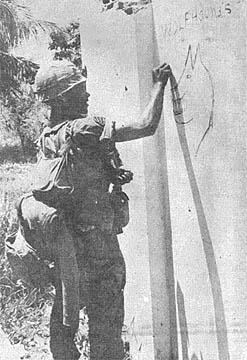 |
VC BEWARE - The "Wolfhounds" have been here. Sgt. Clifton Hardy of Hq., 1st Bn, 27th Inf., draws the symbol of U.S. power that the Wolfhounds claim the VC fear most. Art work was done on a deserted villa wall south of Duc Hoa. (Photo By 1st Lt. Al Karel) |
Page 7 TROPIC LIGHTNING NEWS May 1, 1967
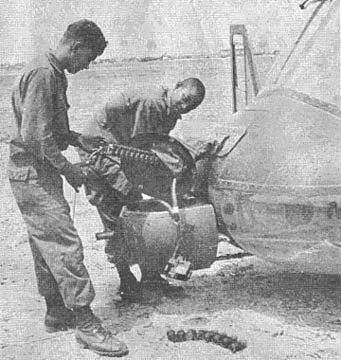 |
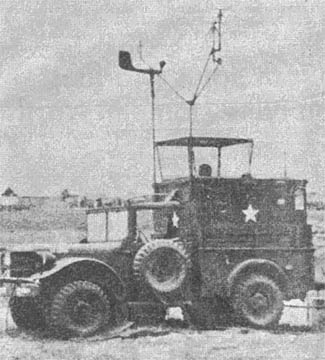 |
| HOT NOSE - Two gunship crew members lead 40mm grenades into the M-5 launcher mounted on a UH-1B helicopter at the Cu Chi Army Airfield. | CONTROL TOWER - This truck is the "tower" that directs all aircraft landing and taking off from the Cu Chi field. Air traffic controllers handle an outgoing or in-comng aircraft every 50 seconds, 24 hours a day. |
Cu Chi Army Airstrip Very Busy Place
By Sp4 Dan Desmond
Twenty miles northwest of Saigon's bustling Tan Son Nhut Airbase is a
subordinate, but also bustling, airfield which is a key link for supply and
troop movement to Hau Nghia Province, War Zone "C" and other northern points.
The Cu Chi Army Airstrip, located in the 25th Inf. Div.'s Cu Chi base camp is
also the home of two major aviation units, the 269th Comb. Avn. Bn. and the 25th
Avn. Bn. These two units with their aircraft make the mile long, quarter mile
wide field one of the busiest in the area.
According to Capt. Bobbie G. Pedigo, 33, of Bowling Green, Ky.. an aircraft
takes off or lands on one of the two runways every 50 seconds around the clock.
Pedigo is the commander of the 341st Airfield Opn. Det. which has operational
control over the beehive facility. The detachment has two officers and 22
enlisted men broken into teams for flight operations, airfield command, service,
communications and a crash-rescue unit.
The crash-rescue unit is always ready to assist any of the aircraft using the
field. The largest task is to follow the paths of larger Air Force planes
landing there. Of these planes, the C-7A "Caribou" uses the field most with an
average of 815 trips monthly. The C-123 "Provider" is also a regular customer
although it is usually scheduled as a troop carrier. The C-130 "Hercules" makes
trips to Cu Chi on special occasions but needs all of the 3100 foot runway for
take off. An additional 200 feet will soon be added to accommodate the huge,
four-engine, turbo-prop aircraft.
The service team has the task of keeping all lodger and transient aircraft
except the Air Force transports, fueled and armed. The fueling area works ten and one-half
hours a day pumping more than 10,000 gallons of fuel into the helicopters. The
armament section issues an average of five tons of machine gun ammunition,
rockets and 40mm grenades each day. All troop carrier helicopters are armed
with two M-60 machine guns. The division gunships carry extra armament in the
form of additional machineguns, rockets and M-1 grenade launchers.
The airfield operations section schedules all flights arriving and departing
Cu Chi and books reservations to all areas including Tay Ninh, Dau Tieng and Tri
Bi in War Zone "C", and Saigon. The "Caribou" flights also transport in-country
R&R personnel to the rest center at Vung Tau.
The courier runs to the three points in War Zone "C", Long Binh and Saigon
account for the majority of scheduled flights and all are made by helicopter.
The team also aids troop movement from the airlift section of the field. In one
month, more than 3800 helicopter flights were logged from the field including
2300 Courier flights.
A major job of the operations section is running the control tower located in
the middle of the field on a three quarter ton truck. The one man facility is
in operation around the clock. PFC Conrad Lee, 21, of Crane, Tex., said five
men work the tower on four hour shifts.
"Most of the ships call in from three to five miles out," said Conrad, "and
we give them runway clearance, wind direction, altimeter and velocity reading."
The same information is given to ships taking off.
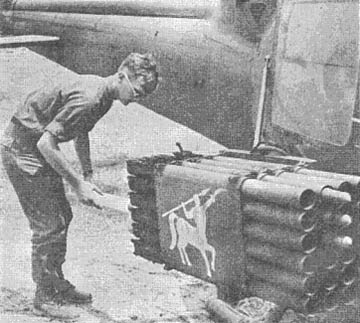 |
FIREPOWER - A, gunship pilot loads 2.75 inch rockets into his aircraft pod at the airfields armament section. Nearly five tons of ammunition and armament are issued daily. |
| SERVICE STATION - A total of 10,000 gallons of fuel is used daily by the aircraft. The fueling area is found at the airfield's resupply pad. |
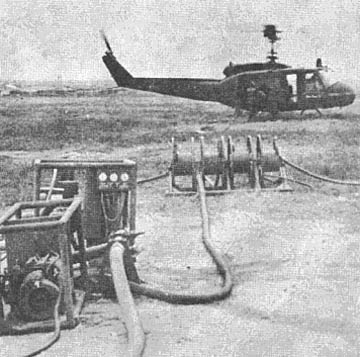 |
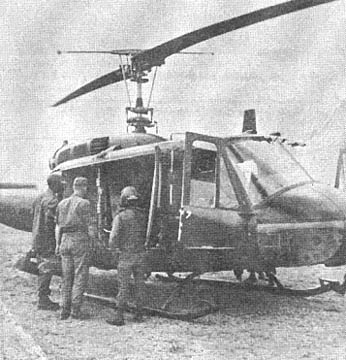 |
IMPORTANT CARGO - Passengers board a courier flight to Saigon near the operations building of the airfield. Flights to the Saigon area run on an hourly schedule 10 hours a day. |
Prek Klok CIDG Camp Mortared
The CIDG camp at Prek Klok was mortared recently with approximately 250 82mm
mortar rounds falling on the small outpost 15 miles northeast of Tay Ninh City
in War Zone C.
The attack began as twilight moved in on the men in the camp and the men of
the 2nd Bn., 77th Arty. who were there in support of 3rd Bde., 4th Div. troops
sweeping the area in the third phase of the mammoth Operation "Junction City".
The first few rounds into the camp hit the ammunition dump and blew two holes
in the soft ground 5 meters deep and 8 meters in diameter. The blast scattered
4.2 mortar rounds and other ammunition throughout the entire perimeter. Some
rounds were located as far as 800 feet from the center of the blast.
Minutes after the attack began, the artillery men were firing defensive
concentrations into the woodline east of the camp. Airstrikes using
antipersonnel bombs saturated the suspected locations of the mortars, while
"Puff, the Magic Dragon" raked the area with fire from its miniguns.
The attack lasted 30 minutes and there were no friendly forces killed.
'Hot Line' For DTOC
A new "Hot Line" between the 125th Sig. Bn. and the 25th Div. Tactical
Operation Center (DTOC) is the first underground installation of its kind in the
Cu Chi base camp.
The new cable, already in operation, is a direct telephone line to all base
switchboards, facilitating faster, more reliable communications in any
situation.
Page 8 TROPIC LIGHTNING NEWS May 1, 1967
VC 'Grip Slips'
Chieu Hoi's Soar in April
The Viet Cong have apparently lost the iron grip on their own people as a
result of Operation "Makalapa."
A spokesman for the 2nd Bde., 25th Inf. Div., stated that the number of
"Chieu Hoi" (Open Arms) ralliers has risen 200 per cent in the past 30 days.
The increase was credited by brigade officers to the heavy pressure placed on
the Viet Cong by allied combat operations and the increased security offered
ralliers.
"The control of the Viet Cong in this area was so strong in many cases, that
ralliers feared what the VC would do to them if they came to the allied side,"
explained Capt. James Meador of Milton, W. Va., a brigade staff officer.
The massive operations in the area provided the security needed to insure
safety for Viet Cong who took advantage of the "Chieu Hoi" program.
Leaflet drops carried out by the brigade's psychological operations personnel
explained the program thoroughly to prospective ralliers.
Specially equipped helicopters carrying high powered public address systems
blared the "Chieu Hoi" message throughout the combat area, especially after
contact had been made with the Viet Cong.
"These methods were effective," said Meador, "but the greatest single reason
for the increase in the number of ralliers was the intensity and size of allied
operations in the area."
Brigade forces made intensive sweeps of the vast pineapple field areas along
the Oriental River. More than 500 Viet Cong bunkers were destroyed in a single
day of the operation.
Helicopters swept brigade soldiers into unprepared areas constantly
maintaining the pressure on the Viet Cong.
"It was this pressure, plus the opportunity to come forward that convinced
them to move to the side of South Vietnamese government," Meador concluded.
| ONLY HER HAIRDRESSER - Red Cross representative Shelley Stimson just wanted to cool off, but is subjected to full "Cacti Blue" wash treatment including shampoo. She was visiting the 2nd Bn., 35th Inf. which is on Operation "Pershing." (Photo by 1st Lt. Peter Wascher) |
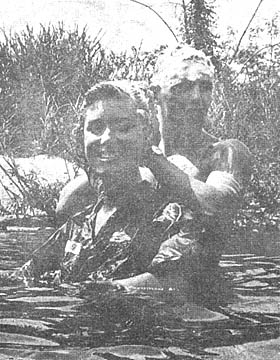 |
196th Joins Marines At New Home in North
The 196th Lt. Infantry Brigade recently completed an airlift to their new
home at Chu Lai Marine Base.
The brigade, under the command of Brig. Gen. Richard Knowles, began the
airlift on April 10 to the area 375 miles northeast of Saigon. The 196th will
operate under control of Maj. Gen. H. Nickerson, commander of the 1st Marine
Division.
Military spokesmen said the brigade would primarily protect the revolutionary
development program in troubled Quang Tri and Quang Ngai provinces, freeing the
Marines for direct combat with the new threat arising from the north. This
program of developing rural areas has been a favorite target of the Communists.
The 196th soldiers are veterans of jungle fighting in War Zone C near the
Cambodian border. It was in this area they inflicted some of the heaviest
losses of the war on the North Vietnamese and Viet Cong.
An Army spokesman said the 196th joined two U.S. Marine divisions and
approximately two and one-half Vietnamese government divisions in combating the
rising guerrilla activity near the northern frontier.
Patrol Clicks, Gets Charlie
The Viet Cong in the Boi Loi Woods couldn't wait to be ambushed by the
"Bobcats." They blundered into a patrol led by SSgt. Carson Peacock Jr., before
his men actually had time to complete their ambush site.
"We were just setting up when we saw four Viet Cong 350 meters away,"
Peacock, of Benson N.C. said. "We all opened fire immediately, killing one and
wounding another who left a trail of blood as he ran away." The body was found
with a pistol belt, canteen, medical bag and rice. The blood trail from the
wounded Viet Cong was discovered the next day. It had been missed because of
the darkness.
The ambush patrol of Co. B, 1st Bn. (Mech.), 5th Inf. moved to another ambush
site after they had made the body count.
VC Hit CP
Soldiers of the 1st Bn., 35th Inf. and the 2nd Bn., 9th Arty. had the scare
of their lives when a Viet Cong mine detonated in the center of their forward
command post.
Although the command-detonated mine blew a hole five feet deep and 10 feet
wide and sent shrapnel flying throughout the CP, scratches and bruises were the
only injuries taken.
Men of Alpha Btry., 2nd Bn., 9th Arty., who were bunked on top of the bomb,
had been called to their posts for a fire mission seconds before the explosion
occurred.
The 250-pound bomb and 105mm rounds - believed to be U.S. ammunition which
failed to explode when it was dropped into a nearby VC stronghold a week earlier
- had been buried prior to the "Cacti Green's" arrival in the landing zone.
MSgt. Francis G. Corcoran, who traced the wire leading from the bomb to where
it had been detonated, said the VC had taken great pains to conceal the wire and
bombs.
Former 1/27 Gives 1 R&R
Sgt. Weldon Merchant will enjoy rest and recreation (R&R) with his wife and
two children because of an old "Wolfhound."
Merchant, Co. B, 2nd Bn., 27th Inf., had planned to meet his wife during R&R
in Hawaii. "She was discussing the trip with friends at a club meeting back in
Roanoke, Va.," said Merchant.
Jack Miller, who had served with the unit during the Korean War, heard about
the R&R plan and offered to take Mrs. Merchant and her two children to Hawaii
free of charge.
Merchant said "We are certainly thankful to Mr. Miller and I'm looking
forward to comparing 'Wolfhound' experiences with him in May."
'Wolfhounds' Now Utilizing Psych Warfare in Tunnels
The 1st Bn., 27th Inf. will no longer just be extracting valuable documents
and papers from VC bunkers and tunnels, but will be depositing some literature
of their own.
It has been customary to search bunkers and tunnels for information valuable
to intelligence sections. However, the 25th Inf. Div.'s "Wolfhounds" now plan
to take an active part in the psychological warfare program by depositing
leaflets in any tunnels or bunkers they should come across in their operations.
Capt. Donald L. Harmon, battalion civil affairs officer, will be using this
method rather than solely relying on airdropped leaflets to reach the enemy.
The leaflets will be placed where the Viet Cong cannot miss them if they should
return to their haunts cleared by the "Tropic Lightning" soldiers.
According to Harmon, three types of psywar literature will be used. The
regular "Chieu Hoi" safe conduct pass displays a map designating the locations
where the returning Viet Cong may turn himself in. Also to be used is the
"nostalgic" Chieu Hoi which has references to the Viet Cong's family and home
and is designed to play on the enemy's emotions, in hopes that he will become
"home sick" and want to return to his family. The third leaflet to be used is a
cartoon showing the Viet Cong as a puppet being manipulated by Hanoi.
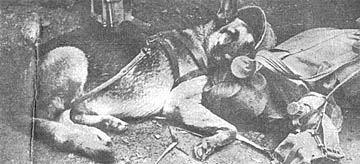 |
POOPED TROOP - A scout dog supporting a Co. C, 1st Bn., 35th Inf. patrol in the 506 valley takes a break to rest. The "Cacti Green," men of the 3rd Brigade Task Force, are on Operation "Pershing." (Photo by 1st Lt. Peter Wascher) |
14 Girls Saved
Quick action by medic Larry A. Flanagan saved the lives of 14 teen-age girls
in My Tho village who were wounded when a combination grenade-claymore mine
booby trap was accidentally tripped.
PFC Flanagan, in the village with the Civil Affairs Team of the 3rd Brigade
Task Force, 25th Inf. Div., was summoned by a panting ARVN soldier.
When Flanagan and 2nd Lt. John D. Reynolds, the civil affairs officer,
arrived, they found four children dead and another 15 seriously wounded.
Flanagan set to work. When he had used all his tourniquets and blood
expander, the ARVNs offered their belts and clothing for use as tourniquets.
Thanks to:
Gary Hartt, 2nd Bn. (Mech.), 22nd Inf.,
for sharing this issue,
Kirk Ramsey, 2nd Bn., 14th Inf. for creating this page.
This page last modified 03-03-2005
©2005 25th Infantry Division Association. All rights reserved.